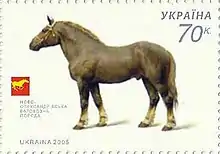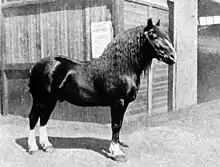Novoolexandrian Draught
The Novoolexandrian Draught (Ukrainian: новоолександрівська ваговозна, Novooleksandrivska Vagovozna) is a Ukrainian breed of draught horse. It is named for the state stud farm of Novo-Oleksandrivka in Bilovodsk Raion of Luhansk Oblast in the easternmost part of Ukraine, where it was bred.[4]:510 It shares its early history with the Russian Heavy Draught bred in Imperial Russia in the second half of the nineteenth century, and until after the Russian Revolution known as the Russian Ardennes; later development took place in Ukraine, where it received official recognition in 1999. It was bred for draught work, but it is also reared for meat and particularly for mare's milk, of which it is a high-yielding producer.
 On a Ukrainian postage stamp, 2005 | |
| Conservation status | |
|---|---|
| Other names | |
| Country of origin | Ukraine |
| Distribution | |
| Use | |
| Traits | |
| Weight | |
| Height | |
| Colour | dark colours[4]:510 |
History

The Novoolexandrian Draught initially developed as a sub-type of the Russian Ardennes (later named Russian Heavy Draught),[3]:323 and so shares its early history. Selective breeding of what would become the Russian Ardennes began in the 1860s at the Petrovsky Agricultural and Forestry Academy in Moscow and at various stud farms including the historic Derkulsky Stud at Danilivka, in Bilovodsk Raion of Luhansk Oblast in the easternmost part of Ukraine.[3]:323 From about this time, stallions of the Franco-Belgian Ardennais heavy horse were imported to the Russian Empire from Sweden in increasing numbers; between 1875 and 1915, their number grew from nine to almost six hundred.[5]:277[3]:323 These were put to local mares; some Brabançon, Percheron and Orlov Trotter blood was also introduced.[6]:250 The aim was to produce a compact draught animal suitable for farm work.[5]:277 The Russian Ardennes was presented at the Exposition Universelle in Paris in 1900.[3]:323 As with other Russian horse breeds, the events of the First World War and the Russian Revolution caused a severe decline in numbers; in 1924, fewer than a hundred Russian Ardennes stallions remained.[3]:323
Several breed lines had developed within the Russian Ardennes, of which the smallest was the Dibrivsky, from the stud farm of the same name at Dibrivka in Myrhorod Raion of Poltava Oblast. In 1923 breeding stock of this line was moved to the stud farm of Novo-Oleksandrivka, which like the Derkulski Stud was in Bilovodsk Raion of Luhansk Oblast in eastern Ukraine.[3]:323 Other horses of the same type were moved there from a collective at Mariupol, in Donetsk Oblast, in 1929, and selective breeding for a compact but powerful draught horse began.[7] In 1970 the Ukrainian or Novoolexandrian type was officially recognised by the Soviet ministry of agriculture.[7] Following the break-up of the Soviet Union and the independence of Ukraine, the Novoolexandrian Draught received official recognition from the Ministry of Agrarian Policy in November 1999.[7]
References
| Wikimedia Commons has media related to Novoalexandrovsk horse. |
- Barbara Rischkowsky, D. Pilling (eds.) (2007). List of breeds documented in the Global Databank for Animal Genetic Resources, annex to The State of the World's Animal Genetic Resources for Food and Agriculture. Rome: Food and Agriculture Organization of the United Nations. ISBN 9789251057629. Accessed January 2017.
- Breed data sheet: Newolexandrian heavy draft / Ukraine (Horse). Domestic Animal Diversity Information System of the Food and Agriculture Organization of the United Nations. Accessed December 2019.
- N.G. Dmitriev, L.K. Ernst (1989). Animal genetic resources of the USSR. FAO animal production and health paper 65. Rome: Food and Agriculture Organization of the United Nations. ISBN 9251025827. Archived 13 November 2009. Also available here, archived 29 September 2017.
- Valerie Porter, Lawrence Alderson, Stephen J.G. Hall, D. Phillip Sponenberg (2016). Mason's World Encyclopedia of Livestock Breeds and Breeding (sixth edition). Wallingford: CABI. ISBN 9781780647944.
- Elwyn Hartley Edwards (1994). The Encyclopedia of the Horse. London; New York; Stuttgart; Moscow: Dorling Kindersley. ISBN 0751301159.
- Élise Rousseau, Yann Le Bris, Teresa Lavender Fagan (2017). Horses of the World. Princeton: Princeton University Press. ISBN 9780691167206.
- M.C. Kemarska, O.A. Calantar, Y.M. Karasik, I.P. Goroshko, D.A. Volkov ([n.d.]). новоолександрівська ваговозна (in Ukrainian). Institute of Animal Breeding, Ukrainian Academy of Agrarian Sciences. Accessed December 2019.